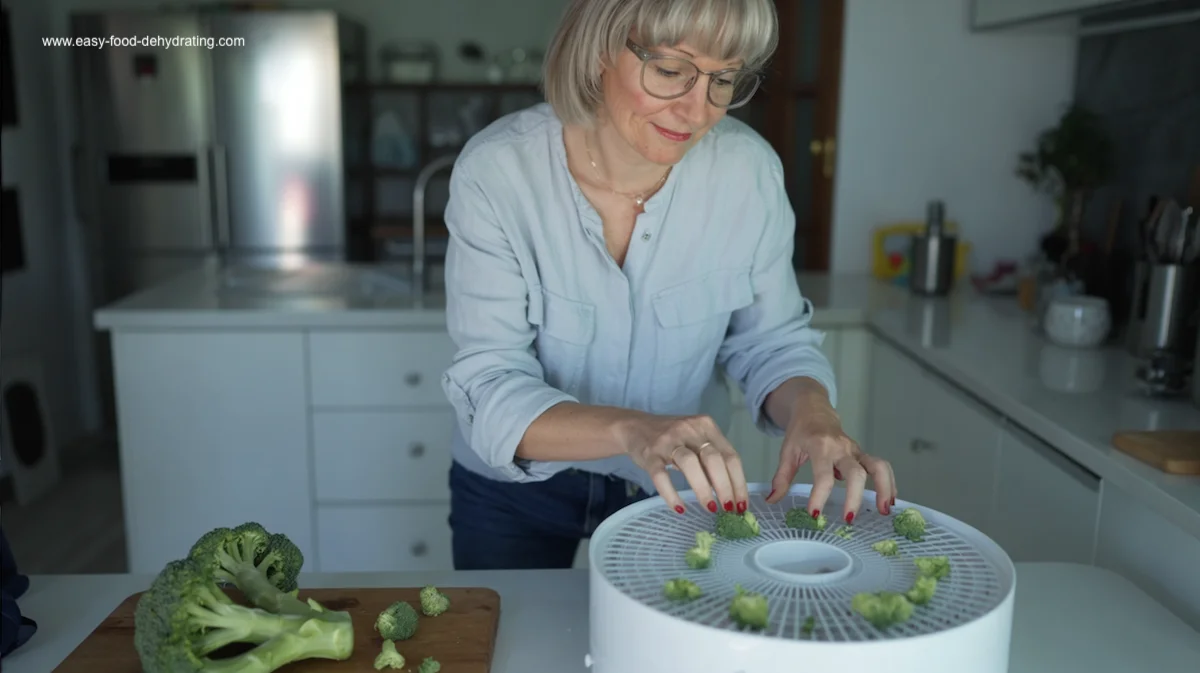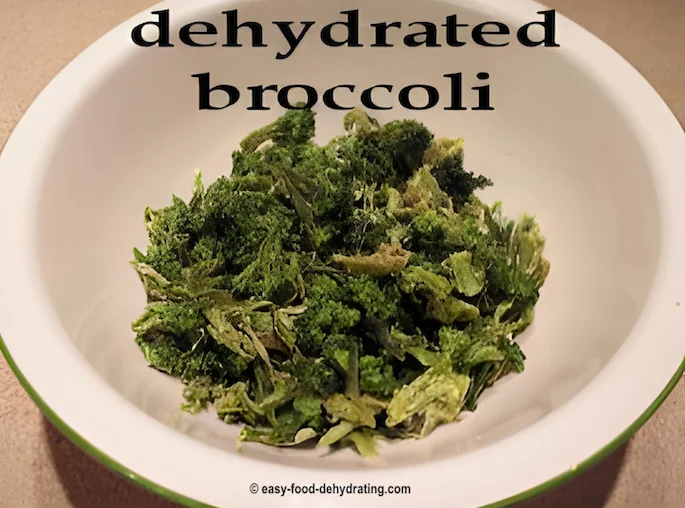What We Mean by “Dehydrate”
Here at Easy Food Dehydrating, “dehydrate” always means using an electric food dehydrator — the easy, reliable way to dry food at home.
- Home
- Dehydrating Vegetables: Step-by-Step Guides by Type
- How to Dehydrate Broccoli
How to Dehydrate Broccoli for
Easy Meals and Snacks

Broccoli is one of the best veggies to keep shelf-stable, and dehydrating makes it possible! With just a few easy steps, you can lock in nutrients, reduce waste, and always have broccoli ready for soups, casseroles, and even crunchy snacks.
✅ Quick Answer: How do you dehydrate broccoli?
To dehydrate broccoli, blanch fresh florets for 2 minutes (or use pre-blanched frozen), spread them on dehydrator trays, and dry at 125–135°F for 6–14 hours until brittle. Store in airtight containers or Mylar bags for up to 2 years.
Whether you start with fresh or frozen florets, I’ll walk you through the exact process so you can confidently dry and store broccoli for year-round use.

While fresh broccoli is unbeatable for salads and veggie trays in the summer, frozen broccoli is a fantastic stand-in when it's out of season.
Just a heads-up: skip the solid frozen blocks and choose bags of loose florets instead - they dehydrate much better and save you a lot of hassle!
Broccoli Nutrition Info.
VITAMINS: Vitamin A, Vitamin K, Vitamin C, Folate, and Choline and has trace amounts of Niacin, Vitamin E, and Thiamine.
MINERALS: Potassium, Phosphorus, Calcium, and Magnesium. Trace minerals are Iron, Zinc, Manganese, and Selenium.
Broccoli also contains Omega-3 and Omega-6 fatty acids too.
Step-by-Step: How to Dehydrate Broccoli (Fresh or Frozen)

If using frozen broccoli, ignore steps 1 and 2 coming up in "From Fresh" below.
NOTE: if your frozen broccoli has clumped together in the bag, prior to opening the bag drop it gently on your countertop a few times – this helps to loosen it up!
Stuck Together Frozen Broccoli? Here’s the Easiest Fix
If you still have a few small clumps on your dehydrator trays, simply run the clumps under clean cool water for a few seconds, and that will do the trick!
Or leave broccoli unopened in the bag in the kitchen sink for an hour. You will be able to slice the big florets easily when partially thawed.
How to Prepare Fresh Broccoli for Dehydrating
- Thoroughly wash your fresh broccoli. Cut into small florets. The broccoli looks like miniature bushes now!
- Blanch in a small amount of boiling water for about 2 minutes. Look how nice and bright the color is! OK, if they're too big, slice them in half so they fit easily on your trays.
- Arrange the broccoli florets on your dehydrator trays, making sure they don't touch each other—give them some breathing room.
- Turn on your food dehydrator and set the temperature between 125°F and 135°F (or per your food dehydrator's instructions) and that's all there is to it!
💡 Tip: Outside the U.S.? Most dehydrating temps here are listed in Fahrenheit - use our quick converter to see the Celsius equivalent for your machine.
- When your dehydrated broccoli is fully dried, it will feel very brittle.
- Drying time for broccoli: between 6-14 hours.
- Please remember to rotate your dehydrator trays for evenly dehydrated broccoli florets.
Tasty Ways to Use Dehydrated Broccoli in Meals
Dehydrated broccoli is a fantastic addition to your pantry — perfect for soups, casseroles, soufflés, and even quick snacks.
And hey, if your kids see you actually enjoying broccoli, you just might inspire them to give it a try too! 😊

Once rehydrated, dried broccoli is incredibly versatile. It makes delicious broccoli cheese soup, adds a pop of flavor to quiches, and even blends into creamy sauces.
Toss in some carrots for extra color and sweetness, and don’t forget a sprig of parsley to make it meal-worthy!
Fresh broccoli might have a slight edge, but dehydrated broccoli comes impressively close — and that's why it's such a smart, shelf-stable backup for your favorite recipes.
💪 Want Even More from Broccoli? Try Sprouts & Powder!
If you’d like to boost your nutrition even further, broccoli sprouts are packed with benefits. And for an easy way to sneak broccoli into smoothies, soups, or sauces, check out our guide to powdered broccoli — it’s a tasty, convenient upgrade!
Frequently Asked Questions About Dehydrating Broccoli
Do I really need to blanch fresh broccoli before dehydrating?
Do I really need to blanch fresh broccoli before dehydrating?
Yes. Blanching for 2 minutes locks in color, flavor, and nutrients. Frozen broccoli is pre-blanched, so you can skip this step.
How long does dehydrated broccoli last in storage?
How long does dehydrated broccoli last in storage?
Stored in airtight jars or Mylar bags with oxygen absorbers, dehydrated broccoli lasts up to 2 years without losing flavor or nutrition.
Can I rehydrate broccoli for fresh-like texture?
Can I rehydrate broccoli for fresh-like texture?
Yes. Soak in warm water for 10–15 minutes or add directly to soups and stews where it softens as it cooks.
What’s the best way to use dried broccoli in meals?
What’s the best way to use dried broccoli in meals?
Add to casseroles, rice, pasta, soups, quiches, or grind into a powder for sauces and smoothies. It’s versatile and adds flavor + nutrition.
How long does dehydrated broccoli last?
How long does dehydrated broccoli last?
When properly stored in airtight containers or Mylar bags with oxygen absorbers and desiccant packets, dried broccoli can last up to 1–2 years.
How do you use dehydrated broccoli in a recipe?
How do you use dehydrated broccoli in a recipe?
Dried broccoli can be cooked or eaten raw. Here are a few dehydrated broccoli recipe ideas...
- Add to Soups/Stews: Add chopped broccoli to any broth, soup, or stew and simmer until very tender and reconstituted before serving. The broth helps rehydrate it well.
- Toss into Rice/Pasta Dishes: Stir chopped dried broccoli into creamy pasta or risotto dishes, or add to a stir-fry for extra nutrition. The broccoli rehydrates and becomes tender during cooking.
- Include in Casserole Mixes: Combine dried broccoli (chopped small), with casserole ingredients like chicken and rice. The broccoli will reconstitute while cooking and baking.
- Sprinkle on Pizza: Rehydrate dried broccoli in warm water for 10 minutes. Drain well and sprinkle broccoli pieces over your favorite pizza crust before adding sauce and cheese, and then baking.
- Roast in the Oven: Spread rehydrated broccoli pieces on a baking sheet, toss with olive oil and seasonings and bake until slightly crispy and browned.
The key is to first chop well and fully rehydrate before cooking through in your favorite dishes and recipes. The result tastes just like fresh broccoli!
Thanks for stopping by to learn how to dehydrate broccoli! Once you try it, you’ll love having a shelf-stable veggie ready for quick soups, casseroles, and snacks.
To keep the inspiration going, grab your free 5 Dried Food Recipes You'll Actually Love PDF below — featuring carrot soup, minestrone, split pea soup, spicy beef jerky, and banana cinnamon rolls. You’ll be set for pantry-ready meals in no time!
Grab 5 Dried Food Recipes You'll Actually Love
Here's where you can get your copy of our all new
5 Dried Food Recipes (That Actually Taste Great)
They're my all-time favorite easy dried food meals!
Get it here right now.
For Free!
Before You Go...
If you enjoyed this page, tap the ❤️ in the lower right-hand corner.
It saves this page to your Grow bookmarks so you can find it again later.
You’ll also see quick share buttons to copy the link, post to Facebook,
or save it straight to Pinterest.
















